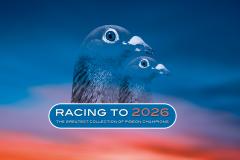De Bock - De Smeyter (Kluisbergen) triumphs at Bourges provincial East Flanders old pigeons
20 Jun 2025
There are fixed values, also in pigeon racing, who every year, when the moments of truth have arrived for them, are invariably present in the front of the races.
Jelle De Bock (playing under the name De Bock - De Smeyter) from Berchem (Kluisbergen) is one of them, focusing on the heavy middle-distance races.
The tandem that is formed with Joost De Smeyter consists of Joost supplying the breeders and Jelle houses and plays the youngsters from these pigeons. They are breeding pigeons that are deliberately selected and sought to score at these distances. Where Joost makes long-distance and middle-distance his main goal, Jelle focuses on middle-distance and heavy middle-distance.
Changed approach
Until last season, the cocks and hens were played on total widowhood. The successes were certainly there and yet it was found that the cocks were losing out to the hens on several occasions. The hens proved to be much more regular in their results and more steadfast.
The necessary conclusions were drawn from this and the decision was taken to play them from this season on with a partner staying at home to try to get the cocks more and better motivated.
The first observations are certainly encouraging and the cocks are more motivated than when they came home and their partner was not there. We started with 32 cocks (which have been winter breeding) and 39 hens which were paired in such a way that they could be basketed on the first Bourges national with a young in the nest.
The run-up in the season's work was characterised by hard, bitty races with surely some (already well flown) stragglers, injured pigeons etc. It was not a flawless start although the results did not show this.
All pigeons were darkened until 2 weeks before Bourges to give them full light afterwards. Bourges national was no fluke for East Flanders and at national level the top pigeons were in other provinces.
Before basketing the pigeons are not shown anything (no dish, no partner) with the aim to basket the pigeons as calmly as possible. The reward is waiting for them when they get home and they quickly realise this. When they arrive home, they are first allowed to half-bake, eat and drink and later they are left with their partner.
Usually, with a normal flight, they are allowed to be with their partner until evening and then they are separated again.
In between, the pigeons are no longer driven with their own transport. Normally, they go into the basket every week, and depending on the intensity of the race that has been flown or the weather conditions, sometimes even a middle-distance race is inserted. The flight rhythm is high enough that there is no need to drive between races.
Training during the season is also limited to one training session a day and Jelle also sees the training sessions becoming shorter as the season progresses...partly because of the weekly races they do.
Care consists of the Versele-Laga range of feed and by-products. Upon arrival home, protein-rich feed (protein-rich breeding mix) to be followed by a combination in the following days of Sportmengeling Champion and Supermengeling. On Wednesday and Thursday, energy mix is fed.
At the beginning of the week the pigeons are given Intestinal Top and Respitop to keep the intestinal function at the right level. Towards basketing, Formolie and Formmix are given. Medically, Pascal Lanneau visits regularly to perform examinations and intervene where necessary.
Jelle, with additional advice and consultation from Joost, and assisted by his father-in-law Johan, takes care of his pigeons with ‘pigeon love’ i.e. the care for the pigeon takes precedence over the results of the race. Strong and good results are not to be despised and are the goal during the season, but always with an eye on the well-being and health of the pigeon. When one is left behind, it is also for Jelle ‘to suffer’ and start all over again.
Grizzly Bourges (BE23-4129370) wins the provincial palm in the old pigeons
It is a beautiful, soft grey hen that beat 3,007 opponents in the province of East Flanders at a minute speed of 1,263 metres per minute.
With this she also scored a 1st club and 7th national from 13,580 pigeons which can be considered a real top performance.
She previously flew top on Noyon, Ecouen, Argenton... and is therefore a very fixed value within the racing team.
Her pedigree can therefore be seen. Her father is Son Roche 624 or just about the best that is in the breeding loft of Joost and Jelle for the heavy middle-distance (Roche is a 100% Willem De Bruijn pigeon and in fact an almost inbred to Willem's Apollo).
The mother is a direct daughter of the super hen Grey from De Vos Yves of Oudenaarde. The grey of Yves De Vos flew 1st Vierzon, 1st Toury, 1st Vierzon,2nd Orléans, 6th La Soutteraine, 2nd Issoudun etc....werkelijk a phenomenal racing hen.
A daughter from this came to the lofts in Berchem-Melden and is already mother of 1st Montoire, 1st Pont, 3rd Noyon, 4th Ecouen and now 1st provincial Bourges....the good come from the good ?
Jelle and Joost also note that Willem De Bruijn's pigeons perform very well in combination-breeding with pigeons that fly strong further distances. A golden tip for other owners ?
For several seasons now, we have been able to publish top results from Jelle and his crew every year. Provincial wins, national top, Olympiad pigeons.
In his own calm amiable style, he continues to build a fine reputation in the heavy middle distance. He nestles neatly among the national top.
We believe this will more than likely be a ‘to be continued’.
Congratulations from the Herbot team !
Geert Dhaenens
















